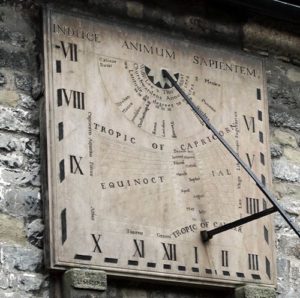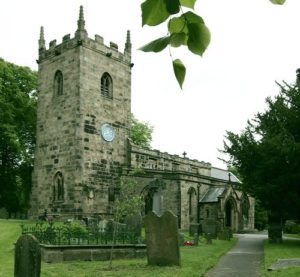This is a typical medieval church standing in the centre of Eyam, surrounded by its graveyard. Although 260 villagers died during the plague in 1665/6, they were all buried close to their homes and only Catherine Mompesson, the rector’s wife is buried in the graveyard.
There has been a church on this site since Saxon times and there is a Saxon cross in the graveyard. This has angels carved at the top and Celtic scroll designs on the base.
The church dates mostly from the 13th/14th centuries. It has a square battlemented tower at the west end with pinnacles and gargoyles. There is a long low flat roofed, clerestoried nave with side aisles and chancel with gable roof. At the ends of the nave and chancel are small carved crosses. On the south chancel wall is a sundial from 1775 which also indicated the time in different places around the globe.
Steps lead into the church with arcades with pointed arches separating nave and side aisles. Above the arches are C15th wall paintings with shields and inscriptions. Lighting in the church makes it almost impossible to photograph these.
In the north aisle is a Saxon font, with a benefactor’s board above. There is a display and information about Eyam and the plague.
A pointed arch leads into the simple chancel. This is roped of and reserved for private prayer. By the altar is Mompesson’s chair. This was made by local craftsmen and was used by William Mompesson. It was discovered in a second hand shop in Liverpool in the C19th and returned to the church.
There is a small bookstall at the back of the church.
Like the rest of the village we found the church underwhelming. It is a nice old church and is on the tourist trail for its links to the plague story. The church is open daily. There is some parking along the street. failing that there is a big car park by the Hall.









